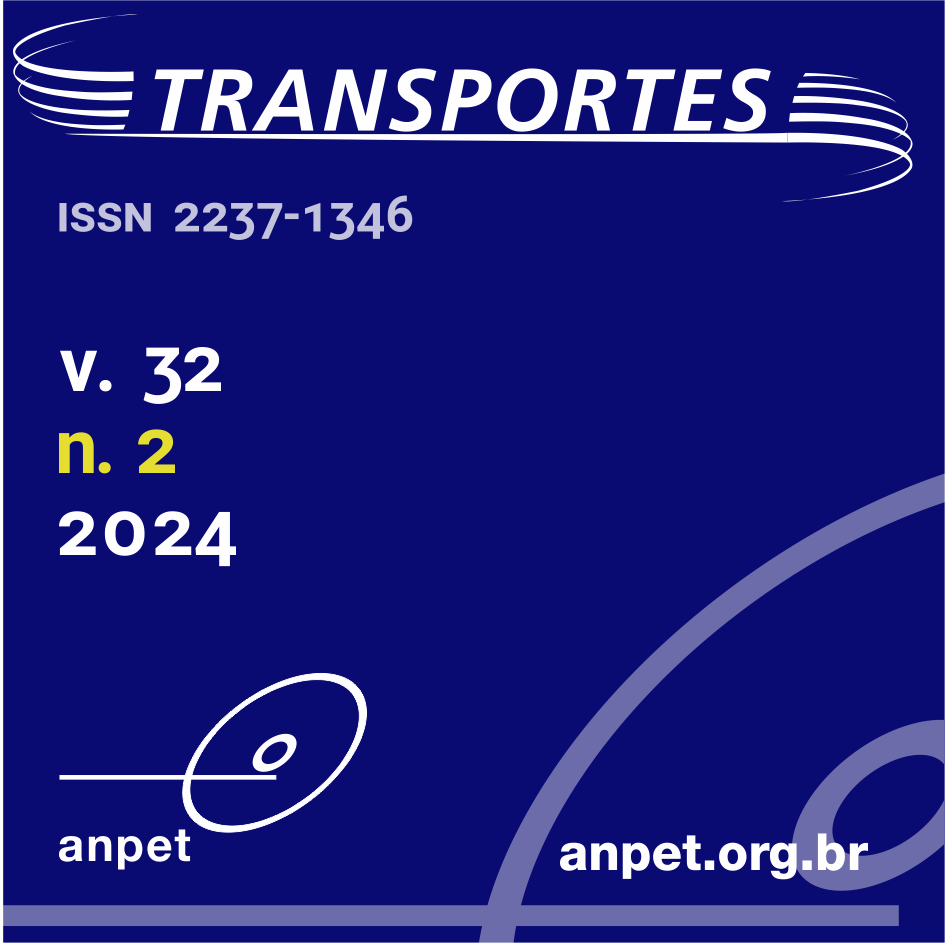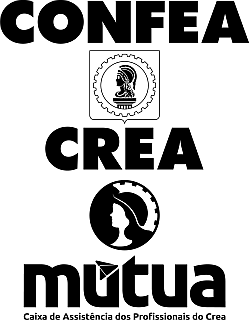Efeito de diferentes tipos de agregados finos na resistência a fadiga e na capacidade de cura de matriz asfáltica de agregado fino
DOI:
https://doi.org/10.58922/transportes.v32i2.2997Palavras-chave:
matriz de agregados finos, mineralogia do agregado, fadiga, capacidade de curaResumo
O trincamento por fadiga é um dos tipos de desgaste mais comuns em pavimentos asfálticos. Cada constituinte do Concreto Asfáltico (CA) e suas interações são relevantes para caracterizar a resistência ao trincamento por fadiga dos CAs. Além disso, para a seleção dos materiais, é essencial considerar não apenas a capacidade do material de resistir ao trincamento por fadiga, mas também a sua capacidade de cura. Materiais que possuem propriedades de autocura podem aumentar a vida de fadiga. Muitos estudos investigaram a autocura de materiais betuminosos ao nível do ligante asfáltico. No entanto, esta propriedade do material pode depender das interações ligante-agregado. Assim, o presente trabalho tem como objetivo avaliar a influência da utilização de diferentes agregados finos na resistência ao trincamento por fadiga e na capacidade de autocura de Matrizes de Agregados Finos (MAFs). Primeiramente, agregados do tipo granito, basalto e micaxisto foram submetidos à caracterização física, morfológica e mineralógica. Em seguida, foram fabricadas MAFs com o mesmo ligante asfáltico utilizando os três diferentes agregados finos. Para avaliar a resistência ao trincamento por fadiga e a capacidade de autocura das MAFs, foram realizados testes de varredura de frequência e varredura de tempo. A teoria simplificada do dano contínuo viscoelástico (S-VECD) foi utilizada para interpretar os resultados desses testes. A composição mineral dos agregados impactou a rigidez e a vida de fadiga das MAFs. Porém, não houve influência significativa dos agregados na capacidade de autocura, uma vez que não houve aumento significativo na vida de fadiga dos materiais após os períodos de repouso nos ensaios de varredura de tempo.
Downloads
Referências
ABNT (2017) NBR 16605: Cimento portland e outros materiais em pó - Determinação da massa específica. Rio de Janeiro: ABNT.
Abo-Qudais, S. and A. Suleiman (2005) Monitoring fatigue damage and crack healing by ultrasound wave velocity, Nondestructive Testing and Evaluation, v. 20, n. 2, p. 125-45. DOI: 10.1080/10589750500206774. DOI: https://doi.org/10.1080/10589750500206774
Ayar, P.; F. Moreno-Navarro and M.C. Rubio-Gámez (2016) The healing capability of asphalt pavements: a state of the art review, Journal of Cleaner Production, v. 113, p. 28-40. DOI: 10.1016/j.jclepro.2015.12.034. DOI: https://doi.org/10.1016/j.jclepro.2015.12.034
Babadopulos, L.F.; G. Orozco; C. Sauzéat et al. (2019) Reversible phenomena and fatigue damage during cyclic loading and rest periods on bitumen, International Journal of Fatigue, v. 124, p. 303-14. DOI: 10.1016/j.ijfatigue.2019.03.008. DOI: https://doi.org/10.1016/j.ijfatigue.2019.03.008
Cala, A.; S. Caro; M. Lleras et al. (2019) Impact of the chemical composition of aggregates on the adhesion quality and durability of asphalt aggregate systems, Construction & Building Materials, v. 216, p. 661-72. DOI: 10.1016/j.conbuildmat.2019.05.030. DOI: https://doi.org/10.1016/j.conbuildmat.2019.05.030
Castelo Branco, V.T.F.; E. Masad; A. Bhasin et al. (2008) Fatigue analysis of asphalt mixtures independent of mode of loading, Transportation Research Record: Journal of the Transportation Research Board, v. 2057, n. 1, p. 149-56. DOI: 10.3141/2057-18. DOI: https://doi.org/10.3141/2057-18
COD (2021) Available at: <https://www.crystallography.net/cod/> (accessed 03/09/2024).
Daniel, J.S. and Y.R. Kim (2002) Development of a simplified fatigue test and analysis procedure using a viscoelastic, continuum damage model (with discussion), Electronic Journal of the Association of Asphalt Paving Technologists, v. 71, p. 619-50.
Daniel, J.S. and Y.R. Kim (2001) Laboratory evaluation of fatigue damage and healing of asphalt mixtures, Journal of Materials in Civil Engineering, v. 13, n. 6, p. 434-40. DOI: 10.1061/(ASCE)0899-1561(2001)13:6(434). DOI: https://doi.org/10.1061/(ASCE)0899-1561(2001)13:6(434)
DNIT (2006) DNIT 031/06 - ES: Pavimentos flexíveis - Concreto asfáltico - Especificação de serviço. Rio de Janeiro: DNIT.
DNIT (2019) DNIT 411/2019 - ME: Pavimentação asfáltica - Misturas asfálticas - Massa específica, densidade relativa e absorção de agregado miúdo para misturas asfálticas. Rio de Janeiro: DNIT.
Fonseca, J.F.; J.E. Sudo Lutif Teixeira; V.T.F. Castelo Branco et al. (2019) Evaluation of effects of filler by-products on fine aggregate matrix viscoelasticity and fatigue-fracture characteristics, Journal of Materials in Civil Engineering, v. 31, n. 10, p. 04019240. DOI: 10.1061/(ASCE)MT.1943-5533.0002891. DOI: https://doi.org/10.1061/(ASCE)MT.1943-5533.0002891
Freire, R.A.; V.T.F. Castelo Branco and K. Vasconcelos (2014) Avaliação da resistência ao trincamento de misturas asfálticas compostas por agregados miúdos com diferentes tamanhos máximos nominais, Revista Transportes, v. 22, n. 3, p. 117-27. DOI: 10.14295/transportes.v22i3.791. DOI: https://doi.org/10.14295/transportes.v22i3.791
Freire, R.A.; L.F. Babadopulos; V.T.F. Castelo Branco et al. (2017) Aggregate maximum nominal sizes’ influence on fatigue damage performance using different scales, Journal of Materials in Civil Engineering, v. 29, n. 8. DOI: 10.1061/(ASCE)MT.1943-5533.0001912. DOI: https://doi.org/10.1061/(ASCE)MT.1943-5533.0001912
Ibiapina, D.S.; V.T.F. Castelo Branco; L. Diogenes et al. (2018) Proposição de um sistema de classificação das propriedades de forma de agregados caracterizados com o uso do processamento digital de imagens a partir de materiais oriundos do Brasil, Revista Transportes, v. 26, n. 4, p. 116-28. DOI: 10.14295/transportes.v26i4.1510. DOI: https://doi.org/10.14295/transportes.v26i4.1510
Karki, P.; R. Li and A. Bhasin (2015) Quantifying overall damage and healing behavior of asphalt materials using continuum damage approach, The International Journal of Pavement Engineering, v. 16, n. 4, p. 350-62. DOI: 10.1080/10298436.2014.942993. DOI: https://doi.org/10.1080/10298436.2014.942993
Kim, Y.R.; D. Little and R.L. Lytton (2003) Fatigue and healing characterization of asphalt mixtures, Journal of Materials in Civil Engineering, v. 15, n. 1, p. 75-83. DOI: 10.1061/(ASCE)0899-1561(2003)15:1(75). DOI: https://doi.org/10.1061/(ASCE)0899-1561(2003)15:1(75)
Kim, Y.R.; D. Little and I. Song (2003) Effect of mineral fillers on fatigue resistance and fundamental material characteristics: mechanistic evaluation, Transportation Research Record: Journal of the Transportation Research Board, v. 1832, n. 1, p. 1-8. DOI: 10.3141/1832-01. DOI: https://doi.org/10.3141/1832-01
Klug, A.B.; A. Ng and L.A. Faxina (2022) Application of the viscoelastic continuum damage theory to study the fatigue performance of asphalt mixtures: a literature review, Sustainability, v. 14, n. 9, p. 4973. DOI: 10.3390/su14094973. DOI: https://doi.org/10.3390/su14094973
Li, M.; G. Wu; E. Fini et al. (2020) Investigating the healing capacity of asphalt mixtures containing iron slag, Construction & Building Materials, v. 261, p. 119446. DOI: 10.1016/j.conbuildmat.2020.119446. DOI: https://doi.org/10.1016/j.conbuildmat.2020.119446
Li, R.; P. Karki and P. Hao (2020) Fatigue and self-healing characterization of asphalt composites containing rock asphalts, Construction & Building Materials, v. 230, p. 116835. DOI: 10.1016/j.conbuildmat.2019.116835. DOI: https://doi.org/10.1016/j.conbuildmat.2019.116835
Li, M.; G. Wu; M. Rajib et al. (2023) Investigating the effect of ultraviolet aging on the healing capacity of bitumen containing taconite tailings, Road Materials and Pavement Design, v. 24, n. 1, p. 267-78. DOI: 10.1080/14680629.2021.2012237. DOI: https://doi.org/10.1080/14680629.2021.2012237
Masad, E.; L. Tashman; D. Little et al. (2005) Viscoplastic modeling of asphalt mixes with the effects of anisotropy, damage and aggregate characteristics, Mechanics of Materials, v. 37, n. 12, p. 1242-56. DOI: 10.1016/j.mechmat.2005.06.003. DOI: https://doi.org/10.1016/j.mechmat.2005.06.003
Mazzoni, G.; A. Stimilli and F. Canestrari (2016) Self-healing capability and thixotropy of bituminous mastics. International Journal of Fatigue, v. 92, p. 8-17. DOI: 10.1016/j.ijfatigue.2016.06.028. DOI: https://doi.org/10.1016/j.ijfatigue.2016.06.028
Moreno, F. and M.C. Rubio (2013) Effect of aggregate nature on the fatigue-cracking behavior of asphalt mixes, Materials & Design, v. 47, p. 61-7. DOI: 10.1016/j.matdes.2012.12.048. DOI: https://doi.org/10.1016/j.matdes.2012.12.048
Moura, B.L.R.; J.E.S.L. Teixeira; R. Simão et al. (2020) Adhesion between steel slag aggregates and bituminous binder based on surface characteristics and mixture moisture resistance, Construction & Building Materials, v. 264, p. 120685. DOI: 10.1016/j. conbuildmat.2020.120685. DOI: https://doi.org/10.1016/j.conbuildmat.2020.120685
Ng, A.K.Y.; A.C. Vale; A.C. Gigante et al. (2018) Determination of the binder content of fine aggregate matrices prepared with modified binders, Journal of Materials in Civil Engineering, v. 30, n. 4, p. 04018045. DOI: 10.1061/(ASCE)MT.1943-5533.0002160. DOI: https://doi.org/10.1061/(ASCE)MT.1943-5533.0002160
Oliveira, L.S.; L.F. Babadopulos and J.B. Soares (2021) Evolution of asphalt binder stiffness during fatigue loading and rest periods and its impact on fatigue life, International Journal of Fatigue, v. 144, p. 106041. DOI: 10.1016/j.ijfatigue.2020.106041. DOI: https://doi.org/10.1016/j.ijfatigue.2020.106041
Palvadi, S.; A. Bhasin and D. Little (2012) Method to quantify healing in asphalt composites by continuum damage approach, Transportation Research Record: Journal of the Transportation Research Board, v. 2296, n. 1, p. 86-96. DOI: 10.3141/2296-09. DOI: https://doi.org/10.3141/2296-09
Phan, T.M.; D. Park and T.H. Le (2018) Crack healing performance of hot mix asphalt containing steel slag by microwaves heating, Construction & Building Materials, v. 180, p. 503-11. DOI: 10.1016/j.conbuildmat.2018.05.278. DOI: https://doi.org/10.1016/j.conbuildmat.2018.05.278
Pivetta, F.C.; L.A. Nascimento and L.A.T. Brito (2020) Proposta de protocolo de ensaio para análise de regeneração em misturas asfálcas através do modelo S-VECD, Revista Transportes, v. 28, n. 4, p. 38-52. DOI: 10.14295/transportes.v28i4.2028. DOI: https://doi.org/10.14295/transportes.v28i4.2028
Rodrigues, J.A.; J.E.S.L. Teixeira; Y.R. Kim et al. (2019) Crack modeling of bituminous materials using extrinsic nonlinear viscoelastic cohesive zone (NVCZ) model, Construction & Building Materials, v. 204, p. 520-9. DOI: 10.1016/j.conbuildmat.2019.01.215. DOI: https://doi.org/10.1016/j.conbuildmat.2019.01.215
Sánchez, D.B.; J. Grenfell; G. Airey et al. (2017) Evaluation of the degradation of fine asphalt-aggregate mixtures containing high reclaimed asphalt pavement contents, Road Materials and Pavement Design, v. 18, n. sup2, p. 91-107. DOI: 10.1080/14680629.2017.1304250. DOI: https://doi.org/10.1080/14680629.2017.1304250
Shen, S.; H.M. Chiu and H. Huang (2010) Characterization of fatigue and healing in asphalt binders, Journal of Materials in Civil Engineering, v. 22, n. 9, p. 846-52. DOI: 10.1061/(ASCE)MT.1943-5533.0000080. DOI: https://doi.org/10.1061/(ASCE)MT.1943-5533.0000080
Underwood, B.S.; C. Baek and Y.R. Kim (2012) Simplified viscoelastic continuum damage model as platform for asphalt concrete fatigue analysis, Transportation Research Record: Journal of the Transportation Research Board, v. 2296, n. 1, p. 36-45. DOI: 10.3141/2296-04. DOI: https://doi.org/10.3141/2296-04
Vasconcelos, K.L.; A. Bhasin and D. Little (2010) Influence of reduced production temperatures on the adhesive properties of aggregates and laboratory performance of fine aggregate-asphalt mixtures, Road Materials and Pavement Design, v. 11, n. 1, p. 47-64. DOI: 10.1080/14680629.2010.9690259. DOI: https://doi.org/10.3166/rmpd.11.47-64
Xu, G. and H. Wang (2016) Study of cohesion and adhesion properties of asphalt concrete with molecular dynamics simulation, Computational Materials Science, v. 112, p. 161-9. DOI: 10.1016/j.commatsci.2015.10.024. DOI: https://doi.org/10.1016/j.commatsci.2015.10.024
Zhang, J.; A.K. Apeagyei; G.D. Airey et al. (2015) Influence of aggregate mineralogical composition on water resistance of aggregate– bitumen adhesion, International Journal of Adhesion and Adhesives, v. 62, p. 45-54. DOI: 10.1016/j.ijadhadh.2015.06.012. DOI: https://doi.org/10.1016/j.ijadhadh.2015.06.012
Downloads
Publicado
Como Citar
Edição
Seção
Licença
Copyright (c) 2024 Miguel Faé Linhares, Jamilla Emi Sudo Lutif Teixeira, Verônica Teixeira Franco Castelo Branco, Wellington Lorran Gaia Ferreira

Este trabalho está licenciado sob uma licença Creative Commons Attribution 4.0 International License.
Ao submeter um manuscrito para publicação neste periódico, todos os seus autores concordam, antecipada e irrestritamente, com os seguintes termos:
- Os autores mantém os direitos autorais e concedem à Transportes o direito de primeira publicação do manuscrito, sem nenhum ônus financeiro, e abrem mão de qualquer outra remuneração pela sua publicação pela ANPET.
- Ao ser publicado pela Transportes, o manuscrito fica automaticamente licenciado sob a Licença Creative Commons CC BY 4.0. Esta licença permite o seu compartilhamento com reconhecimento da autoria e da publicação inicial neste periódico.
- Os autores têm autorização para assumir contratos adicionais separadamente, para distribuição não exclusiva da versão do trabalho publicada neste periódico (por ex.: publicar em repositório institucional ou como capítulo de livro), com reconhecimento da publicação inicial na Transportes, desde que tal contrato não implique num endosso do conteúdo do manuscrito ou do novo veículo pela ANPET.
- Os autores têm permissão e são estimulados a publicar e distribuir seu manuscrito online (por ex.: em repositórios institucionais ou na sua página pessoal) depois de concluído o processo editorial. Como a Transportes é de acesso livre, os autores são estimulados a usar links para o DOI do artigo nesses casos.
- Os autores garantem ter obtido a devida autorização dos seus empregadores para a transferência dos direitos nos termos deste acordo, caso esses empregadores possuam algum direito autoral sobre o manuscrito. Além disso, os autores assumem toda e qualquer responsabilidade sobre possíveis infrações ao direito autoral desses empregadores, isentando a ANPET e a Transportes de toda e qualquer responsabilidade neste sentido.
- Os autores assumem toda responsabilidade sobre o conteúdo do manuscrito, incluindo as devidas e necessárias autorizações para divulgação de dados coletados e resultados obtidos, isentando a ANPET e a Transportes de toda e qualquer responsabilidade neste sentido.










